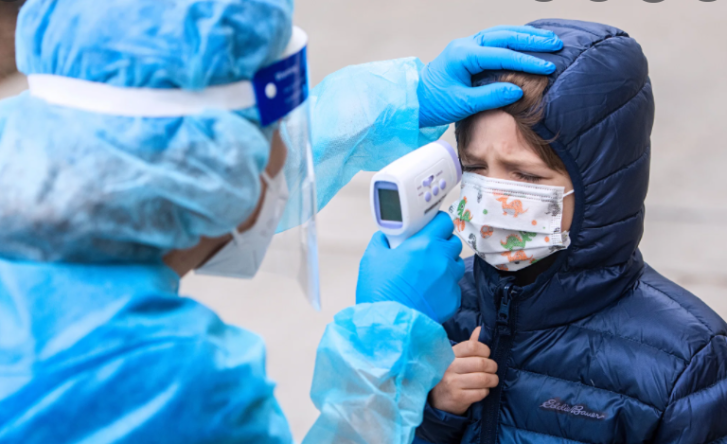Canadian pediatricians are bracing for a potential resurgence of respiratory illnesses, hoping to avoid the fate of hospitals abroad that are struggling with rising numbers of COVID-19 cases among children coupled with an earlier-than-expected surge of another, seasonal virus.
Respiratory syncytial virus (RSV), which causes little more than cold symptoms in most people, is the leading cause of hospitalization among children younger than one in North America. It typically spreads between fall and early spring. While RSV infections all but disappeared last winter amid physical distancing and widespread pandemic lockdowns, several countries, including the United States, Britain, Australia and New Zealand, have seen the virus re-emerge off-season.

In some parts of the world where COVID-19 hospitalizations among children are increasing as public health restrictions ease and the highly contagious Delta variant circulates, the early start to RSV season has stretched some hospitals thin. And Canadian pediatricians say they’re on alert in case the same thing happens here.
“If it doesn’t hit us, it’s good. But we just need to be prepared because there’s no reason RSV wouldn’t come earlier like it has in other places,” said Pascal Lavoie, a neonatologist and clinician-scientist at BC Children’s Hospital.
Hospitals must ensure they are adequately staffed and have the resources to tackle an increase in admissions this summer, which is usually the quietest time of the year for respiratory infections, Dr. Lavoie said.
Quebec is already seeing unusually early cases of RSV. In the last week of July, 56 cases were detected in the province, which is far more than normal at this time of year, said Jesse Papenburg, a pediatric infectious diseases physician at Montreal Children’s Hospital.
RSV infects almost every Canadian by the age of two, and people can be infected multiple times. But first-time infections tend to be most severe in children, since they lack immunity to the virus, Dr. Papenburg said. Young children are also more likely to need oxygen or other respiratory support than older children or adults if they experience an accumulation of fluid or mucus or inflammation in the lungs, he explained.
In a typical RSV season, hospitals commonly see children under the age of one with these respiratory infections. But pediatricians are now wondering if children older than one will also be more likely to get seriously ill because they didn’t encounter the virus this past winter.
“Is that second year of life now going to be more of an at-risk period than it has been prior? We just don’t know because we’ve never experienced anything like this before,” Dr. Papenburg said.
There are many other open questions. For instance, most children at risk of severe RSV infection, including premature infants and those with congenital heart conditions, are given a prophylactic monoclonal antibody, called palivizumab, during typical RSV seasons. Because it is costly and requires monthly injections, palivizumab is usually reserved for these vulnerable groups. If there is off-season circulation of RSV, doctors will have to determine when to start administering the drug, Dr. Papenburg said.
It’s also unclear exactly why RSV cases dwindled last winter. While it’s possible that frequent hand-washing, stay-at-home orders and other pandemic precautions helped prevent its spread, it may also be that SARS-CoV-2, the virus that causes COVID-19, somehow interferes with other viruses and doesn’t allow them to circulate, said Joan Robinson, a pediatric infectious diseases specialist at the University of Alberta. She noted that not only did RSV decline last winter, there were almost no cases of influenza.
This year, she said, “no one can predict what’s going to happen.”
If children contract both RSV and COVID-19 at the same time, doctors believe they likely won’t get much sicker than if they were infected with either virus individually, Dr. Robinson said. What’s more of a concern is that if both viruses are circulating simultaneously, hospital emergency departments could become overwhelmed, she said, noting this is often what happens when spikes in RSV and influenza overlap.
Even though the Delta variant is more contagious, there is still no real evidence to suggest it causes more severe disease in children than previous versions of the coronavirus, Dr. Robinson said. But in places with high numbers of COVID-19 cases, pediatric hospital admissions are increasing as more children become infected.
In the U.S., COVID-19 infections among children have climbed this summer, increasing by 72,000 cases in the last week of July, up from about 39,000 the week before, according to the American Academy of Pediatrics.
At Texas Children’s Hospital, pediatric hospitalist Heather Haq is now seeing a steady increase in admissions after several months of low COVID-19 case counts.
These cases are coinciding with an “unprecedented surge” in pediatric admissions for RSV, Dr. Haq said.
“Having more kids and sicker kids at the same time is a very stressful situation to be in as a pediatric provider,” she said.
There are lessons to be learned from Texas and other parts of the southern U.S. that are currently experiencing a “twindemic” of COVID-19 and RSV, Dr. Haq said. These include following basic public-health measures such as wearing masks and making sure everyone eligible is vaccinated against COVID-19.
Article From: The Globe and Mail
Author: WENCY LEUNG

